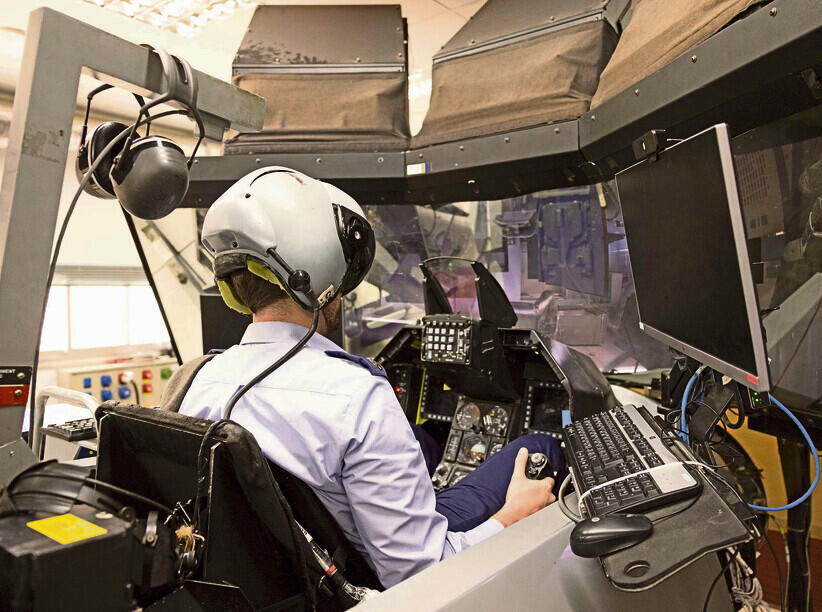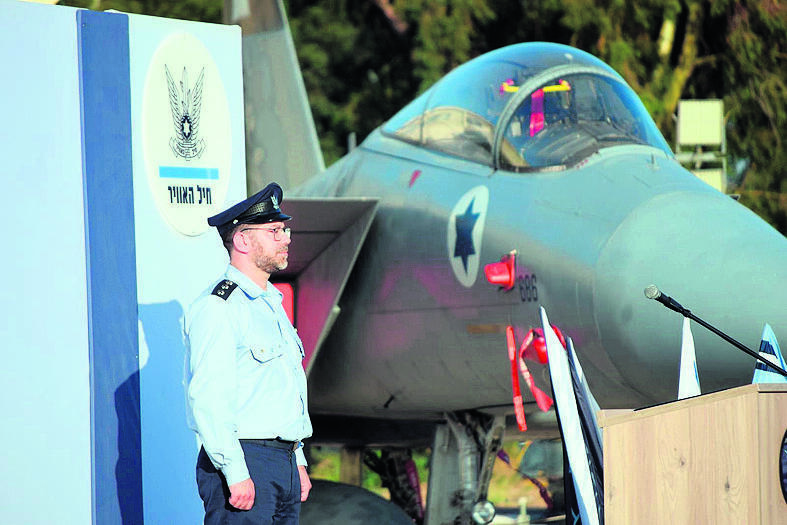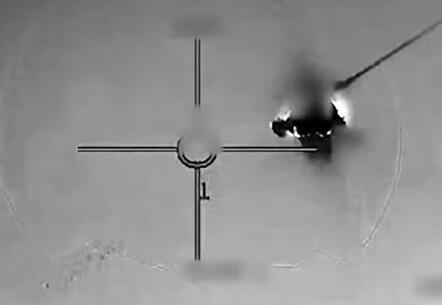Getting your Trinity Audio player ready...
With all due respect to the pilots and missile defense battery operators who intercepted Iranian drones and missiles earlier this month, the real challenge in the operation, dubbed Operation Iron Shield by the IDF, was technological—perhaps the most complex ever faced by any air force.
That night, just before 2:00 AM, the skies over the Middle East were in total chaos: over 300 munitions of various types and sizes from different origins were making their way toward various targets in Israel simultaneously.
Maneuvering between them were dozens of fighter jets from various armies in the region, along with lethal interceptor missiles launched from the ground and sea. In this divine chaos, the task of deciphering the mayhem, tracking the drones and cruise missiles in flight and managing the interceptions by the Air Force jets and "partner nations" was handled by Ofek 324, the technological unit of the Air Force.
Ofek, which typically doesn’t enjoy the limelight as much as its counterpart in the Military Intelligence Unit 8200, is the largest software unit in the IDF (besides the IDF-wide software unit Lotem), comprising hundreds of engineers and developers, including elite reserves and graduates of prestigious programs, and even a select group—about 10% of all those serving in the unit—of Ultra-Orthodox men and women who are civilian employees of the IDF.
Over many years, this unit developed the computerized systems that operated that Saturday night, eliciting worldwide admiration.
The diverse sensors, specially designed to monitor every object in the skies at breakneck speeds, are developed by Israel's defense industries as part of the Iron Dome, Arrow or David's Sling systems.
But this is just the first stage of the process. The precise algorithmic processing, which analyzes raw data from the sensors to provide an accurate picture of the aerial activity, is performed by two computerized systems developed at Ofek. The older system provides a "sky picture" of all aerial vehicles hovering above or around the nation's skies. The second generates the ballistic threat picture.
That night, the unit faced new challenges: the need to deliver precise, relevant information at any moment to each of the strike aircraft and the design of the control and command system that orchestrated it all.
"The main challenge is in detection, in the sensor," says unit commander Col. Dedi Meller, 42, who is being revealed here for the first time. "But once our central system is fed sufficient information, even if it's very raw, the algorithm already knows how to manage and precisely decipher the threat. We have the world's most advanced systems in both ballistic and aerial aspects. And yes, in warfare, there's always that new peripheral element that we also need to prepare for."
Within security constraints, it can be said that these systems can determine whether the hovering object poses a risk—differentiating, for instance, from a mere large bird—and if so, whether it is an aircraft, a ballistic missile or a drone, and exactly what type; whether it is "friendly" or hostile, where it is headed, and when it is expected to hit the target.
Meller, who holds a master's degree in computer science from Tel Aviv University, joined Ofek as a reserve soldier and has risen through various roles over the past 18 years.
"Without going into excessive detail," he says, "just a short time before the attack from Iran, we installed a new capability based on artificial intelligence to improve the discrimination between different types of ballistic threats, to prioritize those that are of more interest to us—and to deal with them in a more focused and faster manner than others; to ensure that in any case, it is not these that will fall upon us, thus protecting strategic facilities with precision. The integration of AI capabilities into our software systems, along with new sensors, allowed for a dramatic improvement in their accuracy."
Did this require special training for the personnel?
"We have an engineering unit that specializes in artificial intelligence as a cross-sectional field. It is primarily staffed by graduates of the IDF’s most prestigious trainings, and they spring into action whenever a challenge arises in any of our content domains. That's what happened this time as well: they were the ones who helped develop the algorithms I spoke about.
During the war, this unit also produced completely independent AI-based applications—not just add-ons or extensions to existing systems—that, for example, assisted in planning flight paths or assessing bombing damage."
Have you encountered any surprises in the ballistic domain since October 7?
"I am not aware of any surprises so far, but of course, I cannot say that we have seen everything. However, during the war, we developed capabilities to deal with an even broader range of threats that we have not yet seen, to prepare for a possible battle on all fronts."
Ofek's ballistic defense system is also the basis for the advanced warning system developed by the IDF in recent years to protect the home front. Using extensive mathematical algorithms, it can predict where and when a missile is expected to strike, allowing the home front command to issue alerts with remarkable speed and accuracy, specifically in at-risk areas.
An improved cockpit
Ofek, established to support the operational activities of the Air Force, has significantly expanded over the years in response to the tasks assigned to it. According to a rough estimate by the IDF, developing the projects managed by the unit in the civilian high-tech sector would be equivalent to about half a billion shekels per year.
It is divided into nine sub-units, located at three different bases. Five of these are development units. One, for example, develops the planning and control systems used by the Air Force commander and senior officers in the bunker at the military headquarters. Another unit develops tools for analyzing data from raw intelligence to generate operational targets for the force's aircraft.
Another Ofek sub-unit has recently integrated a new computer into the F15 and F16 jets of the force, which allows for the immediate streaming of continuous information between air and ground, a process previously done via network communication.
This external computer addition to the aircraft is professionally termed "generic avionics." The interface presents the pilot with their location, the location of other aircraft in the area, the target, and other mission-related information, constantly updating them.
"When the aircraft is in the air," explains Col. Meller, "it is supposed to operate according to the original mission plan, but sometimes things change, and it needs updates on locations, targets, sudden weather changes, and new threats. Until now, this was only conducted through the communication network."
Information sharing between ground forces and pilots has also been upgraded in the war. At Ofek, data communication has been enabled across a broad bandwidth between command-and-control systems used by commanders in the field, providing an integrated and updated situational picture of all participants in combat. This capability allows both the air force command and the pilots themselves to know in real-time the location of ground forces. Algorithms have also been refined to distinguish between hostile targets and civilians to minimize unnecessary harm to uninvolved civilians.
Meanwhile, processes have been developed that dramatically shorten the time from target acquisition and attack planning in the aircraft to execution on the ground. "For example, if there is an urgent need to take down a building to assist ground forces, it requires transferring a precise location to the pilot and additional complex information, which takes about ten minutes to convey in a communication call. If there are multiple targets, double the time. We can now transfer all this data to the aircraft at once, at the push of a button, automatically."
Additionally, upgrades to the pilot's cockpit systems now allow for voice-only operation, which saves valuable time and frees up the pilots' hands and eyes for other urgent tasks.
Every upgrade, change or software addition to the Air Force's aircraft undergoes rigorous adaptation and testing at Ofek labs, which include pilot cockpit simulators fitted with real components identical to those installed in the aircraft; apart from the wings, engine and fuel systems, the entire "brain" of the combat aircraft is here.
4 View gallery


Flight simulator at Ofek 324, using authentic components from fighter jets
(Photo: Oz Moalem)
Israel is among the few countries in the world that American manufacturers allow to intervene and add "boxes" to the computing systems of older aircraft, which are independent computers loaded with new and updated software components. Every lab technician here is required to undergo at least a year of training. Testing of new developments is conducted in collaboration with the pilots themselves.
Beyond the aircraft, the IDF's drones (referred to as RPVs, remotely piloted vehicles, to honor their operators) have also been integrated with advanced algorithmic capabilities from Ofek. This involves globally groundbreaking capabilities: today, an IDF RPV operator receives software recommendations and real-time information based on actual field conditions, enabling them to perform operations much faster than in the past.
"During the six months of the war," says Col. Meller, "we installed hundreds of software versions—from minor improvements to major releases, roughly six times the amount during peacetime. This was possible both due to the intensity of our work and thanks to our reservists: at the peak of the war, a third of the people here were reservists in all roles.
On the first Friday of the war, I convened three former Ofek commanders—today senior high-tech executives—for a consultation meeting. We emerged from that meeting with all three holding reserve duty orders. For me, this is the most touching example of the dedication and contribution of our reservists: each of the three immediately received a significant task to lead, and from that moment, they accompanied us for many long months."





